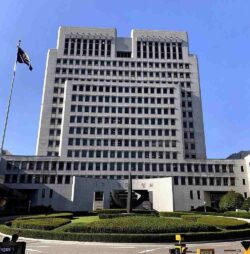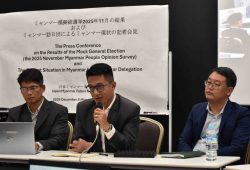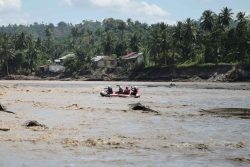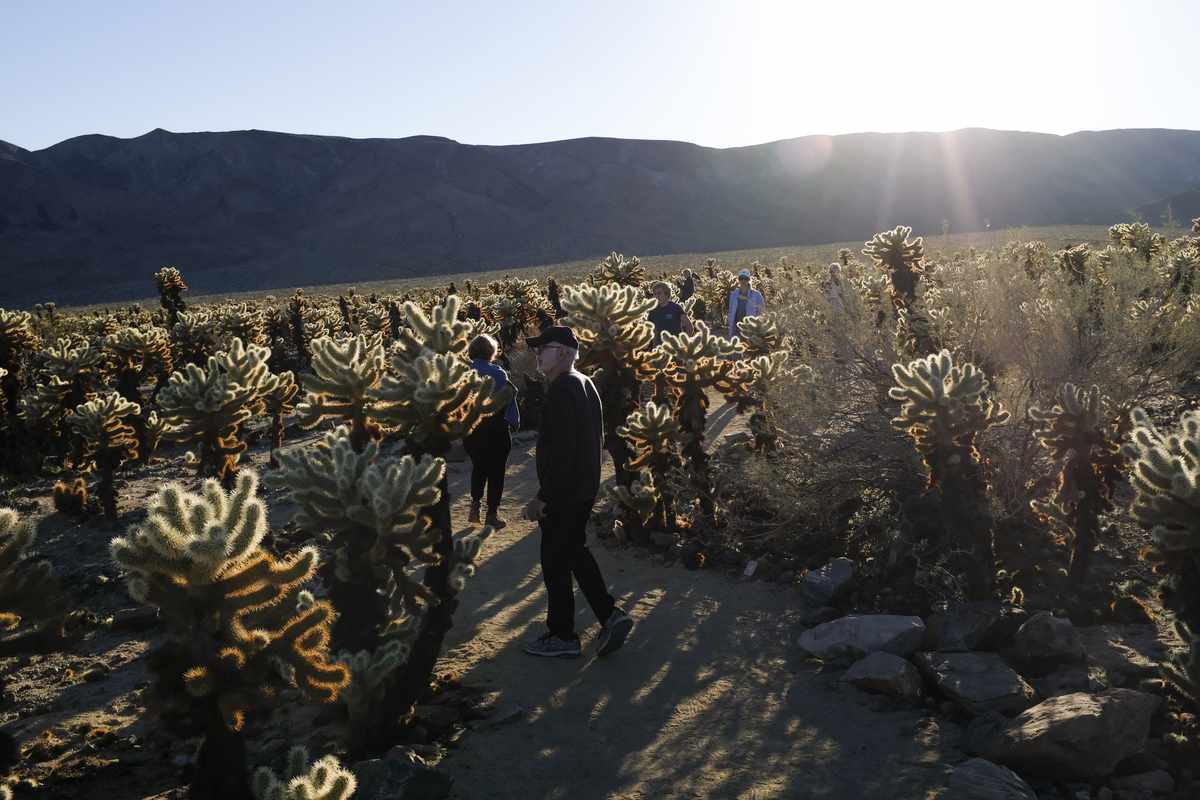
Visitors explore Joshua Tree National Park in December 2018. President Joe Biden plans to expand the park and establish an adjacent national monument.
11:26 JST, January 3, 2025
President Joe Biden plans to create two new national monuments in California in the coming days, according to two people briefed on the announcement, aiming to cement his environmental legacy before President-elect Donald Trump takes office.
The two individuals spoke on the condition of anonymity because the announcement is not yet public.
Biden will sign a proclamation establishing the roughly 644,000-acre Chuckwalla National Monument in Southern California near Joshua Tree National Park, the people said. The move would bar drilling, mining, solar-energy farms and other industrial activity in the area. It also would honor the wishes of several Native American tribes that have revered the landscape for thousands of years, and would expand local Latino communities’ access to outdoor recreation areas.
The president also will sign a proclamation creating the roughly 200,000-acre Sáttítla National Monument in Northern California near the Oregon border, the people said. The Pit River Tribe has spearheaded the campaign to protect that area from energy development.
The White House did not immediately respond to a request for comment.
Biden has already used his executive authority under the Antiquities Act of 1906 to create six new national monuments and expand four others. After signing the proclamations, he will have protected more public lands than any other president in a single term, with the exception of Jimmy Carter.
Trump, in contrast, significantly shrank two national monuments in Utah during his first term. He slashed more than 1.9 million acres in total from the Bears Ears and Grand Staircase-Escalante national monuments – known for their stunning desert vistas and wealth of Native American artifacts.
Three Democratic lawmakers from California – Rep. Raul Ruiz and Sens. Alex Padilla and Laphonza Butler – have introduced legislation to create the Chuckwalla National Monument. Padilla has also championed a bill to protect Sáttítla.
But neither measure has advanced in the divided Congress. The Antiquities Act authorizes the president to protect lands and waters for the benefit of all Americans without congressional approval.
– – –
‘A hugely significant milestone’
The Chuckwalla National Monument will be named after the chuckwalla lizards that roam the junction of the Mojave, Sonoran and Colorado deserts. The region is also home to bighorn sheep, desert tortoises and iconic bird species such as golden eagles and greater roadrunners.
Chuckwalla would be immediately southeast of Joshua Tree National Park, which ranked as the ninth most-visited national park in 2023, attracting more than 3.2 million people that year, according to the National Park Service.
The area is part of the ancestral homelands of several Indigenous peoples, including the Cahuilla, Chemehuevi, Mohave, Quechan and Serrano tribes. The Quechan people say their ancestors emerged from a sacred mountain in Nevada – Avi Kwa Ame, which Biden designated as a monument in 2022 – and then migrated through this stretch of desert, dropping pottery shards as trail markers and leaving petroglyphs as guidance for future generations.
“If someone went and bulldozed the Vatican, that would be the equivalent of desecrating this desert for us,” said Donald Medart, a council member of the Fort Yuma Quechan Indian Tribe.
For the Cahuilla people, the reddish hue of the rocks and mountains comes from the blood of Mukat, the Cahuilla creator god who was exiled to this area. They say that when Mukat died, his remains became vegetation to sustain his people, including mesquite trees whose beans can be cooked or ground into flour.
A monument designation “would be a hugely significant milestone,” said Thomas Tortez Jr., tribal council chairman of the Torres Martinez Desert Cahuilla Indians. “It’s the best way that we can protect our original homelands.”
Interior Secretary Deb Haaland, the first Indigenous Cabinet secretary, visited the site of the proposed Chuckwalla monument in May and hiked a popular trail called Painted Canyon. Interior officials then held a June public meeting on the proposal, where the vast majority of roughly 700 attendees voiced support for the idea.
Several supporters noted that Chuckwalla would provide one of the few outdoor recreation areas accessible to poor and Latino neighborhoods in the Coachella Valley besides Joshua Tree.
“This would serve as an opportunity to close the nature gap particularly affecting communities of color and low-income communities,” said Jazzari Taylor, a policy advocate at the group Latino Outdoors.
The Sáttítla National Monument, meanwhile, would encompass an area known as the Medicine Lake Highlands northeast of the Mount Shasta volcano. The area is often called the headwaters of California because of its crucial role in supplying clean water from volcanic aquifers to communities across the state, including farms downstream.
The 11 bands of the Pit River Tribe also consider the area part of their ancestral homelands. Tribal members use the area to pray and to gather plants for use in cooking and ceremonies.
“Our creation narrative comes out of there,” said Yatch Bamford, chairman of the Pit River Tribe. “It’s like the epicenter for our people.”
Hunters and anglers have cheered the tribe’s campaign to safeguard Sáttítla. They have noted that the area provides vital clean water for trout streams and critical habitat for game species including mule deer, Rocky Mountain elk and pronghorn antelope.
The U.S. Forest Service held a public listening session on the proposed Sáttítla monument on Dec. 7. The vast majority of roughly 500 attendees supported the proposal.
– – –
Stifling clean energy?
Some critics, however, warn that the two monuments could stifle clean-energy development, undercutting Biden’s own ambitious climate agenda as Trump is promising to boost fossil fuels.
In particular, Sáttítla could prevent the development of proposed geothermal energy plants, which generate electricity by harnessing the heat trapped deep beneath the Earth’s surface. In the process, they produce far fewer planet-warming greenhouse gas emissions than coal or natural gas plants.
Bamford said the Pit River Tribe supports clean energy – just not on this land.
“We’re not against clean energy in any way – it’s just that clean energy and sacred sites don’t mix,” he said. “If these projects were proposed in a different area that was less impactful, then that is a discussion we would have.”
Some local officials worry that Chuckwalla, for its part, could quash solar development in one of the country’s sunniest locales.
Officials in Blythe, Calif., a city of roughly 18,000 people east of Joshua Tree, issued a June press release opposing Chuckwalla’s proposed boundaries. They called for redrawing the monument map to exclude tens of thousands of acres on either side of the city.
“We’re in the Sonoran Desert, one of the hottest and sunniest places in the United States,” Blythe Vice Mayor Johnny Rodriguez said in an interview. “We need green energy for our state, and this would be the natural place for it.”
Blythe Mayor Joseph DeConinck added that “if this becomes a monument, there’s going to be more restrictions, more rules.”
Such concerns point to a tension between two of Biden’s environmental priorities: protecting public lands and speeding the nation’s transition to green energy. But supporters of Chuckwalla contend it would complement – not clash with – solar development in the desert.
Supporters note that in 2016, federal and state agencies adopted the Desert Renewable Energy Conservation Plan, which designated areas suitable for development as well as places that should be protected for their biological, cultural and recreational values. They say the monument map was drawn to avoid nearly 400,000 acres that could host sprawling solar farms.
“The monument does not overlap with any of the development areas for solar; it fits right around them like a puzzle piece,” said Stephanie Dashiell, an environmental consultant who works with a coalition of nonprofit groups supporting Chuckwalla.
Dashiell added that the coalition has done “extensive outreach” to Blythe officials and has garnered “overwhelming support from municipalities other than Blythe.”
Aaron Weiss, deputy director of the Center for Western Priorities, a conservation group, said 98.5 percent of the monument would cover areas that the plan already designated for conservation. The remaining 1.5 percent of the land has no current designation.
“There was a long, multiyear process of getting all of the stakeholders at the table to come up with a long-term plan for the California desert, including conservation and renewable energy,” Weiss said. “And the proposed maps for the Chuckwalla monument are a reflection of that.”
"News Services" POPULAR ARTICLE
-

American Playwright Jeremy O. Harris Arrested in Japan on Alleged Drug Smuggling
-

Taiwan President Shows Support for Japan in China Dispute with Sushi Lunch
-

Japan Trying to Revive Wartime Militarism with Its Taiwan Comments, China’s Top Paper Says
-

Japan’s Nikkei Stock Average as JGB Yields, Yen Rise on Rate-Hike Bets
-

Japan’s Nikkei Stock Average Licks Wounds after Selloff Sparked by BOJ Hike Bets (UPDATE 1)
JN ACCESS RANKING
-
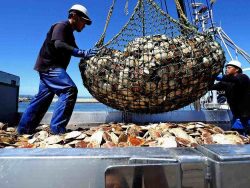
Japan’s Hopes for Seafood Exports Shot Down in China Spat
-

Essential Services Shortage to Hit Japan’s GDP By Up to ¥76 Tril. By 2040
-

Japan to Charge Foreigners More for Residence Permits, Looking to Align with Western Countries
-

Japan GDP Down Annualized 1.8% in July-Sept.
-
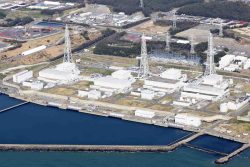
Niigata Gov. to OK Restart of N-Plant; Kashiwazaki-Kariwa May Be Tepco’s 1st Restarted Plant Since 2011


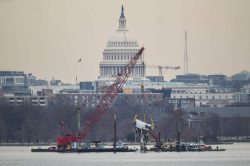
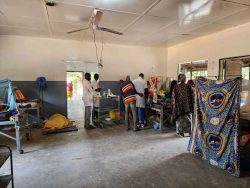




_0001-250x189.jpg)



